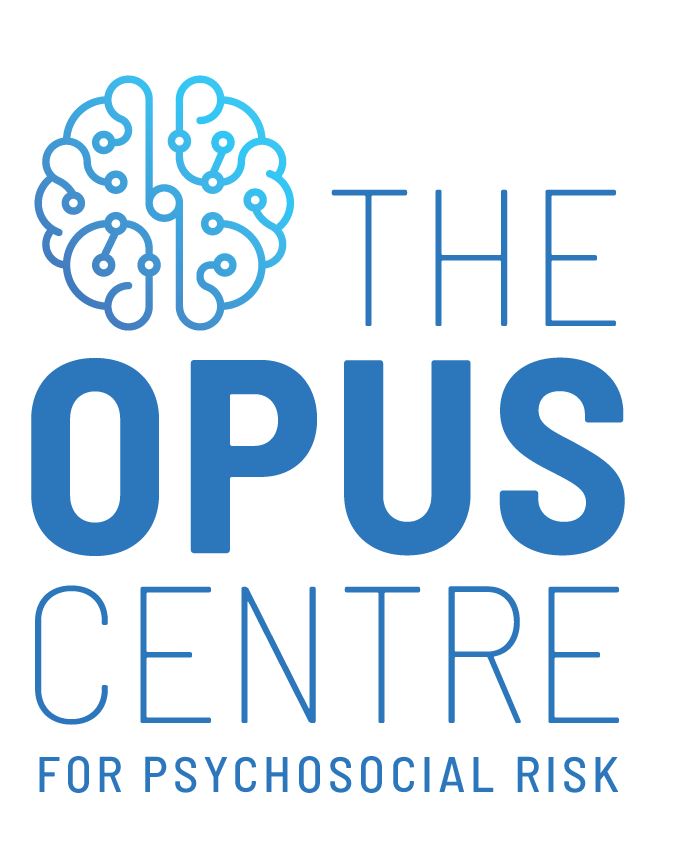

Resources
The Opus Centre have brought together a range of resources that organisations from our events have found useful. If you have any other resources you think should be included please feel free to contact us and let us know.
You might also like to check out other pages on this website such as:
How to Create a Psychologically Safe Work Environment
Psychosocial Risk and Hazard Management Definitions
Please note that while we have based these definitions on highly regarded international sources there may be jurisdictional variations and we recommend you defer to definitions in your region.
Psychological health is “a state of wellbeing in which the individual realizes his or her own abilities, can cope with the normal stresses of life, can work productively and fruitfully, and is able to make a contribution to his or her community” (The World Health Organisation, 2001 p.1).
Psychosocial factors at work include job design, social, organisational and management contexts of work that have the potential to impact worker health and wellbeing (Cox & Griffiths, 2005).
Stress at work includes harmful physical and psychological responses that occur when the requirements of the job do not match the capabilities, resources, or needs of the worker, which can lead to poor health, illness, or injury (Sauter et al., 1999).
Psychosocial hazards occur when job demands are unreasonable, and/or adequate resources are not provided these job design and management contexts can lead to psychological or physical harm and are therefore defined as a psychosocial hazard.
Psychosocial risk is the potential of a psychosocial hazard occurring and the likelihood that it will cause harm (Leka et al., 2017)
Psychosocial risk assessment provides information about the nature and severity of the psychosocial hazards through a careful examination of work-related factors. Specifically, the risk assessment identifies the likelihood of the psychosocial hazard occurring and the extent of harm it poses to the worker. The best psychosocial risk assessments examine the psychosocial hazards that cause harm and the protective work-related factors that have the potential to promote positive outcomes.
Psychosocial risk management involves the systematic and on-going process of identifying risk in a workplace and controlling and reviewing the risks, as far as is reasonably practicable.
Psychosocial hazard management involves the systematic process of managing psychosocial hazards in a workplace and controlling the likelihood of harm, as far as is reasonably practicable.
Psychosocial health and safety represents the collective experience of psychological health and safety, in terms of the absence of ill mental, emotional, social and spiritual health symptoms and behaviours, and the presence of positive indicators and behaviours.
Psychosocial safety climate reflects the shared perceptions of the policies, practices, and procedures in a work unit/organisation for the protection of workers’ psychological health and safety (Dollard & Bakker, 2010).
Psychological safety refers to the shared perceptions about the individuals’ beliefs on how safe it is to engage in risky interpersonal behaviours, such as voicing concerns about health and safety (Edmondson, 1999).
Health Industry Psychological Health and Safety Resources
ISO 45003 Resources
This resource is a free online course that provides a comprehensive review of the latest international standards for managing psychosocial risks. The course includes detailed descriptions of WHS systems and processes for risk management in an Australian context. Recommended for persons with a high level of responsibility for WHS in an organisation.
Stress Cafe Resource
Australian Workplace Barometer (AWB)
The AWB is a national psychosocial risk surveillance tool which has collected data since 2009 on working conditions for over 7 000 employees across Australia. This resource provides information on levels of psychosocial factors by industry, state, and a range of other demographics. A useful tool for practitioners to identify potential risk factors for employees
FairWork Ombudsman - Difficult Conversations in the Workplace
Fair Work Ombudsman – Difficult conversations in the workplace
This resource includes an easy to read downloadable guide for managers and employers wanting to learn more about having difficult conversations in the workplace. Topics include when to have the conversation, how to prepare and how to manage emotions with examples and tips throughout. Recommended for any person in a leadership role that involves supervising staff.
Occupational Violence & Customer Aggression
iCare – Managing patient and client aggression
This resource provides a concise summary regarding the impact of client aggression on employees with practical steps for employers to take action. While the content is described in the context of health care industry the principles are relevant to any workplace with exposure to client or customer aggression and there are links to similar research from other industries.
Academic References for Psychosocial Climates and Worker Health
Psychosocial Safety Climate: A Review of the Evidence
Zadow, A., Dollard, M.F., Parker, L., & Storey, K.
In M.F. Dollard, C. Dormann, & M.A. Idris, (Eds.), Psychosocial Safety Climate, Springer, 2019
This book chapter provides a comprehensive summary of the extensive research into the links between workplace climates for psychological health, work-related factors, and worker health and productivity outcomes. The content includes evidence of workplace climates predicting job strain, bullying and harassment, engagement, and worker psychological health outcome. It includes evidence of climates theory across industry, occupation, and cultures.
Dollard, M.F., & Bailey, T.S.
In M.F. Dollard, C. Dormann, & M.A. Idris, (Eds.), Psychosocial Safety Climate, Springer, 2019
This chapter provides a detailed description of the translation process for psychosocial climate theory and research evidence into applied practice. It includes a case study utilising a psychosocial a risk assessment tool as part of best practice implementation of a psychosocial risk management program within an organisation.
Psychosocial Risk and Hazard Management Definitions
Please note that while we have based these definitions on highly regarded international sources there may be jurisdictional variations and we recommend you defer to definitions in your region.
Psychological health is “a state of wellbeing in which the individual realizes his or her own abilities, can cope with the normal stresses of life, can work productively and fruitfully, and is able to make a contribution to his or her community” (The World Health Organisation, 2001 p.1).
Psychosocial factors at work include job design, social, organisational and management contexts of work that have the potential to impact worker health and wellbeing (Cox & Griffiths, 2005).
Stress at work includes harmful physical and psychological responses that occur when the requirements of the job do not match the capabilities, resources, or needs of the worker, which can lead to poor health, illness, or injury (Sauter et al., 1999).
Psychosocial hazards occur when job demands are unreasonable, and/or adequate resources are not provided these job design and management contexts can lead to psychological or physical harm and are therefore defined as a psychosocial hazard.
Psychosocial risk is the potential of a psychosocial hazard occurring and the likelihood that it will cause harm (Leka et al., 2017)
Psychosocial risk assessment provides information about the nature and severity of the psychosocial hazards through a careful examination of work-related factors. Specifically, the risk assessment identifies the likelihood of the psychosocial hazard occurring and the extent of harm it poses to the worker. The best psychosocial risk assessments examine the psychosocial hazards that cause harm and the protective work-related factors that have the potential to promote positive outcomes.
Psychosocial risk management involves the systematic and on-going process of identifying risk in a workplace and controlling and reviewing the risks, as far as is reasonably practicable.
Psychosocial hazard management involves the systematic process of managing psychosocial hazards in a workplace and controlling the likelihood of harm, as far as is reasonably practicable.
Psychosocial health and safety represents the collective experience of psychological health and safety, in terms of the absence of ill mental, emotional, social and spiritual health symptoms and behaviours, and the presence of positive indicators and behaviours.
Psychosocial safety climate reflects the shared perceptions of the policies, practices, and procedures in a work unit/organisation for the protection of workers’ psychological health and safety (Dollard & Bakker, 2010).
Psychological safety refers to the shared perceptions about the individuals’ beliefs on how safe it is to engage in risky interpersonal behaviours, such as voicing concerns about health and safety (Edmondson, 1999).
Health Industry Psychological Health and Safety Resources
Healthcare Staff Wellbeing, Burnout, and Patient Safety: A Systematic Review – PubMed (nih.gov)
Staff safety and wellbeing – Staff safety – Patient Safety Learning – the hub (pslhub.org)
ISO 45003 Resources
Foundations course
This resource is a free online course that provides a comprehensive review of the latest international standards for managing psychosocial risks. The course includes detailed descriptions of WHS systems and processes for risk management in an Australian context. Recommended for persons with a high level of responsibility for WHS in an organisation.
Stresscafé
Australian Workplace Barometer (AWB)
The AWB is a national psychosocial risk surveillance tool which has collected data since 2009 on working conditions for over 7 000 employees across Australia. This resource provides information on levels of psychosocial factors by industry, state, and a range of other demographics. A useful tool for practitioners to identify potential risk factors for employees
Performance Management Resources
Fair Work Ombudsman – Difficult conversations in the workplace
This resource includes an easy to read downloadable guide for managers and employers wanting to learn more about having difficult conversations in the workplace. Topics include when to have the conversation, how to prepare and how to manage emotions with examples and tips throughout. Recommended for any person in a leadership role that involves supervising staff.
Occupational Violence & Customer Aggression Resources
iCare – Managing patient and client aggression
This resource provides a concise summary regarding the impact of client aggression on employees with practical steps for employers to take action. While the content is described in the context of health care industry the principles are relevant to any workplace with exposure to client or customer aggression and there are links to similar research from other industries.
Academic references for psychosocial climates and worker psychological health
Psychosocial Safety Climate: A Review of the Evidence
Zadow, A., Dollard, M.F., Parker, L., & Storey, K.
In M.F. Dollard, C. Dormann, & M.A. Idris, (Eds.), Psychosocial Safety Climate, Springer, 2019
This book chapter provides a comprehensive summary of the extensive research into the links between workplace climates for psychological health, work-related factors, and worker health and productivity outcomes. The content includes evidence of workplace climates predicting job strain, bullying and harassment, engagement, and worker psychological health outcome. It includes evidence of climates theory across industry, occupation, and cultures.
Dollard, M.F., & Bailey, T.S.
In M.F. Dollard, C. Dormann, & M.A. Idris, (Eds.), Psychosocial Safety Climate, Springer, 2019
This chapter provides a detailed description of the translation process for psychosocial climate theory and research evidence into applied practice. It includes a case study utilising a psychosocial a risk assessment tool as part of best practice implementation of a psychosocial risk management program within an organisation.







